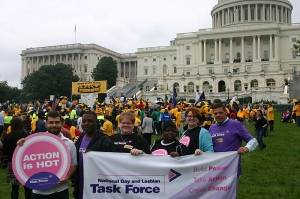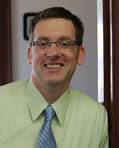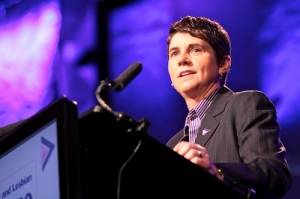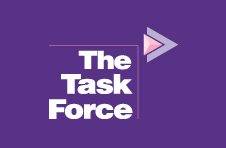
For the past 24 years, the National Gay and Lesbian Task Force (NGLTF) has held a conference called National Conference on LGBT Equality: Creating Change. This event is for LGBT activists, community organizers, staff and leaders of LGBT centers, foundations, schools, and offices of public officials (just to name a few). It is a training ground for leaders in our community, to help us become more effective agents for change. It’s for anyone and everyone who works for progress, equality, and social justice for LGBT people:
The primary goal of the Creating Change Conference is to build our movement’s political power from the ground up to secure our overarching goal of full equality, social justice and dignity for lesbian, gay, bisexual and transgender people in the United States.
 This year’s conference took place in Baltimore, Maryland, on January 25–29. And for the first time they held a Lobby Day on Capitol Hill, where the attendees received a quick lesson in advocacy training in everything from “discrimination in employment to the need for safe schools.”
This year’s conference took place in Baltimore, Maryland, on January 25–29. And for the first time they held a Lobby Day on Capitol Hill, where the attendees received a quick lesson in advocacy training in everything from “discrimination in employment to the need for safe schools.”
For the second year in a row, board members from the UP Center of Champaign County attended Creating Change. I confess that I didn’t know they did this last year. I think that sometimes, because of the amazing, fun, high-profile events that the UP Center organizes and hosts throughout the year, it’s easy to forget (or take for granted) that most of their time and effort is spent working for safe communities for LGBTQ youth, equality, education, and health services.
So to make up for last year’s neglect, and to show off for them a little bit, I asked Kevin Bowersox-Johnson (President) and Megan Paceley (Vice President) to talk about their experiences at Creating Change. I interviewed Kevin in person and Megan through email.
~~*~~
Smile Politely: I think it’s great that you were able to attend this conference.
 Kevin Bowersox-Johnson: It is. Even though I was part of a community center in California, it really was, for me, the focus of that community and that community only. When we started the UP Center, we, as a group, really felt a need to be a part of a bigger movement. And as a part of that, we wanted to get from the movement, but we also wanted to give back to the movement.
Kevin Bowersox-Johnson: It is. Even though I was part of a community center in California, it really was, for me, the focus of that community and that community only. When we started the UP Center, we, as a group, really felt a need to be a part of a bigger movement. And as a part of that, we wanted to get from the movement, but we also wanted to give back to the movement.
SP: Absolutely. It’s the only way that what you do will work and last. And this is a huge national conference, with incredibly important leaders and allies attending. It must be extremely satisfying.
Bowersox-Johnson: We were sitting there with senators… And the state of the movement address was so empowering this year. You’re just in awe of the queer community when you’re there.
SP: We often focus so much on things that we’ve done wrong or things that we still need to improve and work on … we have to. But taking some time to stop and focus on what we’ve done right, what we’ve accomplished, in the last 365 days … that’s got to feel great.
 Bowersox-Johnson: Rea Carey (right, executive director of NGLTF) was amazing. She started off with all of our accomplishments. She focused on the micro issues throughout the country — an individual city’s accomplishments in a rural school, to statewide marriage equality — and she was able to name the states that differentiated equal marriage versus civil unions, and all of those that have occurred in the last 365 days.
Bowersox-Johnson: Rea Carey (right, executive director of NGLTF) was amazing. She started off with all of our accomplishments. She focused on the micro issues throughout the country — an individual city’s accomplishments in a rural school, to statewide marriage equality — and she was able to name the states that differentiated equal marriage versus civil unions, and all of those that have occurred in the last 365 days.
But then she went on to say that, with all of these accomplishments, we still have the right and a responsibility to be frustrated with the movement. And she said that we will be called to action. So it was this very well, very fluid, very natural transition from each one of these pieces in her keynote. Really, it truly was empowering. You left there thinking, ‘I’m exhausted; I feel like I dedicate my life to this, and yet I still need to go out there and do more.’ That’s how good it was.
SP: All of that hard work. It means something. It accomplishes something.
Bowersox-Johnson: Yes.
[ed. You can view Carey’s State of the Lesbian and Gay Movement Address here.
And here are some highlights from the conference:]
SP: How did this come about? Why did you decide to attend this conference?
Megan Paceley: Kevin and I went together for the first time last year. I had heard about it, and we decided to submit a proposal for a workshop on how to start a community center in a small town.
Bowersox-Johnson: We presented a workshop called “UP, UP and Away: Starting a New Community Center in a Small Town.” It was my first, ever large-scale queer conference. I had been to smaller scale — much smaller scale — conferences, and it really spoke to me, being in the same space with so many people: the diversity, the different needs, the level of workshops, the quality of workshops that they had. The level of production that goes on at this conference is amazing.
So this year, we decided to propose again, and we took our experience that we’re getting from the UP Center and presented as a way of sharing what we do. This year’s workshop was called “Moving on UP,” and it was specific to creating big events on small budgets.
Paceley: We co-presented, and we discussed marketing, producing events, and building partnerships and how this has been important in he UP Center’s development.
Bowersox-Johnson: We focused mainly on our Pride event, and how we had a zero budget our first year, and how a fairly large-sized committee with zero budget pulled it off, chaired by Evelyn Tardy and Caroline Nappo.
Both of our workshops were well-attended. We each had about 15–20 people at our respected workshops. Meghan and I presented one together, and then she presented solely on her other one.
 Paceley: I presented on some research I’ve been doing with Ramona Oswald and Jennifer Hardesty (Human and Community Development). Ramona has data from the Rainbow Illinois survey (2010), and we examined factors that influence adult LGBTQ individual’s involvement in LGBTQ organizations (such as he UP Center, LGBTQ groups within churches, etc.). The presentation was on our preliminary findings; we’re working on more analysis now and plan to publish soon (I hope!).
Paceley: I presented on some research I’ve been doing with Ramona Oswald and Jennifer Hardesty (Human and Community Development). Ramona has data from the Rainbow Illinois survey (2010), and we examined factors that influence adult LGBTQ individual’s involvement in LGBTQ organizations (such as he UP Center, LGBTQ groups within churches, etc.). The presentation was on our preliminary findings; we’re working on more analysis now and plan to publish soon (I hope!).
SP: Did you get good feedback?
Paceley: We don’t officially get our evaluations right away, but the audience in both of our sessions appeared to be engaged with us and the materials, so I think they went well!
Bowersox-Johnson: Last year’s evaluations were spotless. They were really well received. The people in attendance thanked us for focusing on smaller towns because they felt like some of the larger community centers there weren’t able to really speak to their needs. These people were coming from centers similar to the UP Center’s small budget (or no budget), whereas larger centers have millions of dollars and much different issues that they’re sharing. Both are needed, yes, but ours last year was well received. And the few verbal comments that we got after the presentation were very positive.
SP: Did you also attend for professional development?
Bowersox-Johnson: We did both.
Paceley: Creating Change appeals to a wide variety of audiences. There are activists, youth, social workers, educators, LGBTQ organizers, and researchers. I love that I can find workshops to attend that are also based in research, but have a practice-oriented focus, which helps my academic career. I can also find presentations and workshops on youth development and organizing, fundraising, and other areas that impact my work with the UP Center.
Bowersox-Johnson: This conference has every possible topic known to human beings. There are 37 to choose from each break-out session.
SP: Damn. That’s much more than I thought.
Bowersox-Johnson: Yes, 37 to choose from. And there’s a focus on smaller communities.
SP: So what other workshops were you able to fit in?
Paceley: Other than my presentations, I attended workshops on conducting oral histories, finding LGBT-oriented jobs, and racial and economic justice.
Bowersox-Johnson: The UP Center of Champaign County is a member of CenterLink, which is an organization specifically developed to help promote the success of LGBT community centers across the nation. And they always have a half-day retreat there, so I attended that. It’s a room where about 75–100 executive directors get together and we introduce ourselves and we talk about one or two issues that we’d like to focus on. We break that into themes and then break into small groups to troubleshoot individually amongst directors. So, I get to network with directors like Lorri Jean (Los Angeles Gay and Lesbian Center), Modesto Tico Valle (Center on Halsted), people from Las Vegas, New York, all across the country who run community centers. The UP Center is definitely usually the smallest in the room budget-wise, but networking is a huge portion of this conference for us. We get to benefit from the experience of those who have been here before and who are at a much bigger scale.
SP: Right. I imagine that they probably have issues and concerns directly because of their size and enormous budgets.
Bowersox-Johnson: This can be challenging sometimes. There’s no way that Champaign-Urbana will ever be a $54 million budget community center, and that’s OK, but it is a challenge being in a room full of people who have that kind of budget because we do have different issues. But the benefits are so amazing that you just can’t help but be in awe when you’re in a room with people who are doing wonderful work. That’s a big portion of the conference for me.
Another workshop that I attended involved understanding why people get involved in community centers, but mostly I was on the community center track. They have different tracks: a community center track, a youth track, a kink track, etc. [I admit that I giggled like a schoolgirl here — ed.]
SP: What did you learn that will benefit the UP Center, as well as our community?
Paceley: Something I already knew, but was reinforced through my participation and attendance in the conference, is how we, as a community center, must be aware of all of the sub-groups within our community. This means paying attention to the “B” and the “T” in the LGBT acronym, but also paying attention to issues of sexism, racism, classism, abilism, etc. Our community is diverse and we must be sure we accurately represent that diversity in our programs and events.
Bowersox-Johnson: I think for me, the biggest thing is the networking and seeing the queer movement at such a large scale. Like, here we are in the Hilton, and even the public bathrooms were all gender neutral. They were all transformed to gender neutral.
SP: That’s awesome.
Bowersox-Johnson: So, total parties in the bathrooms! [Laughter]
SP: [Laughter] And I missed this?!
Bowersox-Johnson: In my lifetime, I’ve seen dorms at Berkeley, when I lived in California, transform to gender neutral floors versus male and female floors, to seeing at this large a scale, where it’s … I have no idea if there were any other meetings or conferences going on. I assume not, because we probably took up the entire space, but if there were, those people — or anybody coming there for a business meeting — they were subjected to, thankfully, gender neutral bathrooms.
Which even for me is a challenge. And it’s not the gender neutral part; it’s just sharing a bathroom in general that I have an issue with. But that’s a personal thing. [Laughter]
SP: Right there with you.
Bowersox-Johnson: [Laughter] Thank you! … And the accessibility concerns: they had an accessible check-in desk; a sign language interpreter at the main events; scent-free rooms; a satellite room, which held 1,500+ people. So, for example, if someone needed a scent-free environment, just down the hall was a separate room for them, and the program was telecast into that room. I was truly impressed with how fully inclusive the conference is. And to walk among people comfortable in their own skin — drag, trans identity — whatever the case may be. Amazing.
SP: It’s needed. We need this every once in a while. I attended the Michigan Womyn’s Music Festival last year for the first time, and I think I’m going to return every year until I’m too old to set up a tent. It’s a community that I need to be immersed in every once in awhile.
Bowersox-Johnson: It can be a little overwhelming, just in pure numbers, but it becomes clear that this is possible, this is happening.
SP: Were there any disappointments?
Paceley: None that I can think of!
Bowersox-Johnson: None, other than a workshop I was planning to attend getting canceled, but that can’t be helped. I attend a lot of conferences as an educator (that’s my professional trade), and Creating Change is definitely the best, most well organized I’ve ever attended. I’m sure that things went wrong in the background, but as a participant I didn’t see it.
SP: Do you plan to attend future Creating Change conferences?
Paceley: I’m sure I will. Next year it may conflict with another conference I need to attend, but we’ll see. It’s in Atlanta so I may have to just make it work.
Bowersox-Johnson: Absolutely. We’re already planning for that, and we’ve applied for grants to take youth with us in the future. We’re really looking at growth and having a bigger representation there, including members of the community, directors, and definitely youth. It’s important to us to give back to the community because we’re only in existence because of the community.
~~*~~
 To learn more about the National Gay and Lesbian Task Force and the Creating Change Conference, go here. Or check out their Facebook page.
To learn more about the National Gay and Lesbian Task Force and the Creating Change Conference, go here. Or check out their Facebook page.
Read all about this year’s conference here.
If you’d like to help the UP Center with their future hopes and dreams, you can donate here.
Front page image from Creating Change 2012 program (pdf)








